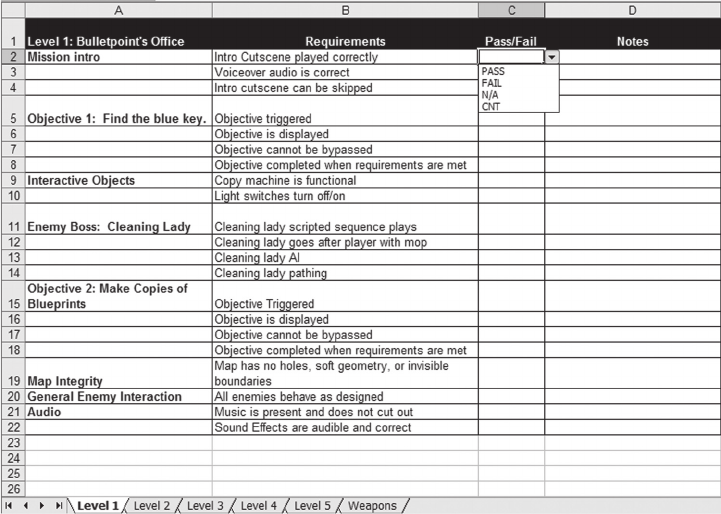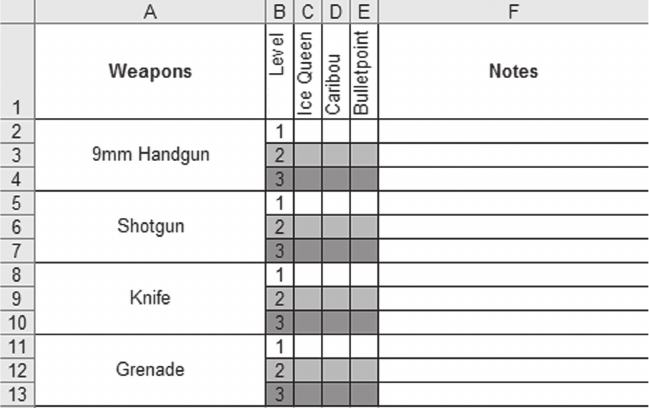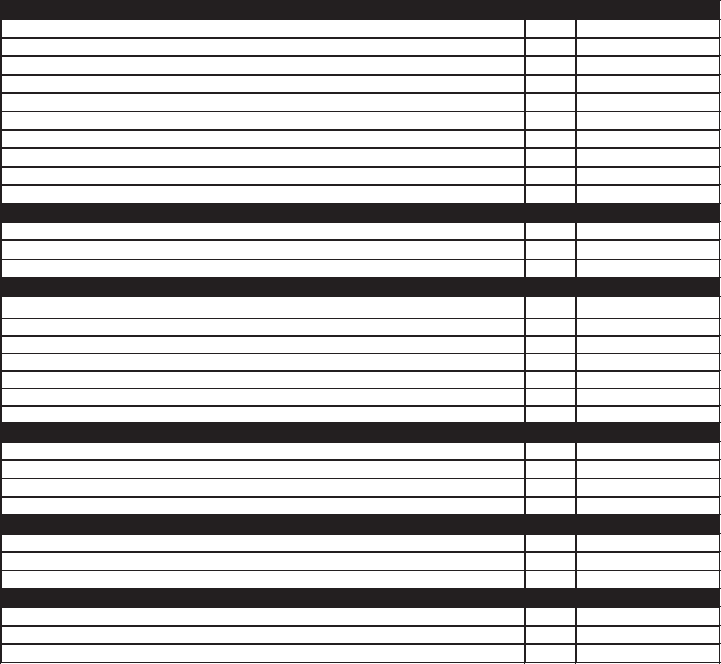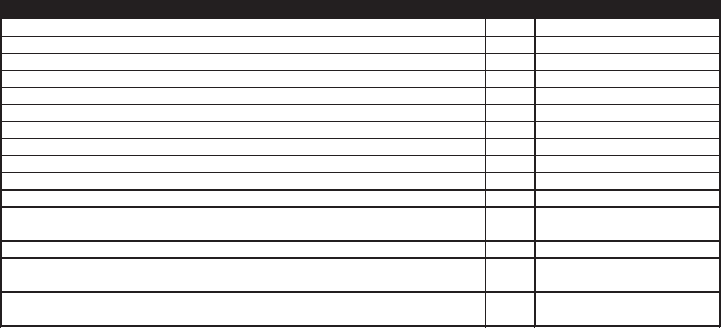
446 THE GAME PRODUCTION HANDBOOK, 2/E
The team submits the first CRC on July 27, 2009. The QA department starts
first by checking that all major areas of the game load and that the localizations
are correct. The QA team then starts going through the test plan. While the QA
testers check the game against the test plan, the associate QA analyst begins
checking the documentation, legal text, logo, and customer support information
to ensure that everything is correct and ready to go. All of these items are in
order and so the QA team continues to work through the test plan.
While the QA department checks the CRC, the production team also contin-
ues checking the build as well. The producer has locked everyone out of source
control to prevent anyone from checking in any changes or bug fixes to the game.
The production team is not planning to make any additional bug fixes, unless
the QA department finds an issue with the code release candidate. One of the
designers finds some minor typos in some of the in-game text, and would like to
implement the correct text if a second code release candidate is needed. The
producer approves this fix since it is a low risk change to a text file.
The artists find some issues with the way one of the special effects is work-
ing in the game and also ask if they can implement a fix in a second CRC. After
discussing the issue with the artists and engineers, the producer decides against
making this fix. The fix is a bit risky since some of the code would need to be
FIGURE A.36 Pass/fail test plan for Justice Unit.

CASE STUDY—GAME PRODUCTION CYCLE 447
changed and some art assets would need updating. This issue is a cosmetic one
and doesn’t have a large impact on gameplay, so the producer decides that it
is too risky to make this change for a second code release candidate. However,
if the QA department finds a major crash bug with the game that would entail
a code change, the producer will consider the request to fix the special effect
again. If the code needs to be changed anyway to fix a bug, it might not be as
risky to implement a code change to fix the special effect.
On the third day of testing (July 29, 2009), the QA department does find a
major bug in the game that they feel should be addressed. While it is not a crash
bug, it does prevent the player from progressing in the game. The bug is reproduc-
ible and QA is able to isolate the exact steps to reproduce it. While they are inves-
tigating the bug, they determine that at least 25 percent of players will encounter
this issue and that it needs to be fixed for the final game. The QA lead also recom-
mends that three other bugs be addressed at this time—they are not major issues,
but the changes are low risk and will improve the final gameplay experience.
The production team starts working on a second code release candidate and the
QA department continues testing the first CRC to see if any more issues are uncov-
ered. Fortunately, they don’t find any other issues during the code release checks.
It takes the team three days to generate another CRC and they send another CRC
to the QA lab on August 3, 2009. The producer presents a detailed list of each bug
change to the QA lead. The QA lead tests these changes first to confirm that the
fixes are made and working correctly. Once these changes are confirmed, the QA
department starts running through the test plan and code release checklist again.
FIGURE A.37 Checklist test plan for Justice Unit.

448 THE GAME PRODUCTION HANDBOOK, 2/E
The second CRC is in testing for four days, and another major issue is un-
covered. At the end of the day on August 6, 2009, the QA lead asks the team to
make a third CRC. The team works over the weekend so they can have the third
CRC ready for testing, first thing Monday morning on August 10, 2009. For
the third CRC, the production team only addresses the specific fixes that were
requested by QA.
The third CRC goes into testing first thing Monday morning. The QA team
works extended shifts to check the third CRC as quickly as possible. The console
submission deadline is quickly approaching, and the QA team feels confident
that the third CRC can be ready to go. By working extended shifts, the QA de-
partment is able to complete all the code release checks by the end of the day on
August 13, 2009. They approve the third CRC for submission.
GENERAL INFORMATION P/F Additional Notes
Have all bugs been addressed?
All "will not fix" bugs approved?
Can game be played from beginning to end?
Have cheat code been removed?
Is debug software removed?
Has game passed all areas of the test plan?
PC Compatibility checks completed?
Is correct customer support information listed?
Is this version approved for submission to third parties?
Are the correct age ratings and disclaimers being displayed?
THIRD PARTY APPROVALS
Has this version passed the technical requirements checks for Microsoft?
Has this version passed the technical requirements checks for Sony?
Has this version passed the technical requirements checks for Nintendo?
LOCALIZATIONS
Is correct customer support information listed?
Is game text displaying the correct language?
Are voiceovers playing in the correct language?
Are packaging manuals translated correctly?
Has game received linguistic approval?
Does correct legal text and copyright information display?
Does game have all necessary age ratings?
LEGAL
Have appropriate licensors signed off on the game?
Are clearances secured for all licensed content (such as music)?
Does game contain correct version of the EULA?
Is warranty and customer support info correct?
PACKAGING
Does package contain legal and copyright information?
Are logos and other icons on package correct?
Is the manual finalized and approved?
GOLD MASTER CHECKS
Have gold masters beeen virus scanned and determined to be virus free?
Is gold master identical to the approved gold release candidate?
Has gold master been installed and verified on appropriate hardware?
FIGURE A.38 Code release checklist.

CASE STUDY—GAME PRODUCTION CYCLE 449
Code Release Schedule
In order to meet the October 13, 2009 ship date for the console version, the pro-
ducer works with Microsoft and Sony to get make sure the game gets approved
in a timely fashion. The final approval process generally takes six to eight weeks if
the code is relatively bug-free, the game has no major issues, and all of the techni-
cal requirements are fulfilled. Supergame Studios has a lot of experience work-
ing on console titles, so they are confident in their ability to fulfill the technical
requirements and get the game approved in no more than two submissions.
Figure A.39 is a general code release schedule for Justice Unit. This sched-
ule allows the game to have a pre-certification submission, and go through two
approval cycles in the final certification process and meet the desired ship date.
The pre-certification submission is scheduled for May 27, 2009. This is when the
game is basically at beta and all the technical requirements are implemented.
The console manufacturers check the technical requirements in the game and
write up a detailed report about any requirements that needs to be fixed before
the final certification process. The team gets the report back in early June, which
offers them plenty of time to implement any necessary feedback and changes.
FIGURE A.39 Code release schedule for Justice Unit.
Final console certification is scheduled for August 17, 2009. The team is
actually able to submit the game three days earlier on August 14, 2009. This
turns about to be a good thing, because they forgot to submit the PEGI software
ratings certificate and Microsoft puts a hold on the submission until the PEGI
certification is sent on August 17. There was some chance the ship date could
slip if it had taken a few days to get the certificate to Microsoft. The producer has
built some padding into the submission schedule to account for any unexpected
minor delays.
Microsoft starts reviewing the final submission August 17, 2009 and after
reviewing it for 10 days, fails the submission because there were a few areas

450 THE GAME PRODUCTION HANDBOOK, 2/E
where the game was not following the technical requirements correctly. They
also encountered one reproducible crash bug.
The team reviews the report and investigates the crash bug. It takes them
about five days to fix and test the crash bug, and to make some adjustments to
how the technical requirements are implemented in the game. They submit the
game for a second time on September 7, 2009. This time the submission is ap-
proved on September 18, 2009. The game is sent immediately for replication
and manufacture.
Because there is ample time for the replicator to press the discs and pack-
age the game, the game is able to easily make the October 13, 2009 ship date.
If the approval process had taken more time, the publisher would have worked
with the replicator to reduce the amount of time in the schedule to package and
ship the game. For extra money, the publisher can have the replicator put a rush
on the order and work over the weekend—which can save 7 to 10 days in the
schedule. The publisher could also pay extra shipping costs to get the product to
stores in two days, instead of the normal five to seven days. Luckily, Supergame
Studios came through and completed the game on time, so the publisher did not
have to negotiate with the distributor or pay any extra to get the game on the
store shelves in time.
A.5.3 Completing Testing
Supergame Studios has completed the testing phase and consults their checklist
to confirm that they have completed all the major testing tasks. Figure A.40 is
the testing checklist.
FIGURE A.40 Testing phase checklist.
TESTING CHECKLIST Y / N NOTES
VALIDATE PLAN
Is test plan written?
Is game plan updated for QA?
Has test plan been updated with any changes to the game plan?
Are testing milestones accounted for in the schedule?
Is bug-tracking software available for the testers and development team?
Are all areas of the game tested?
Are all bugs regressed and closed?
CODE RELEASE
Has development team submitted a final code release candidate?
Is there ample time in the schedule for QA to complete the test plan on the
code release candidate?
Has QA approved the product for code release?
CONSOLE ONLY: Has code released game been submitted to console
manufacturer for approval?
CONSOLE ONLY: Has console manufacturer approved game for final
replication?
..................Content has been hidden....................
You can't read the all page of ebook, please click here login for view all page.
